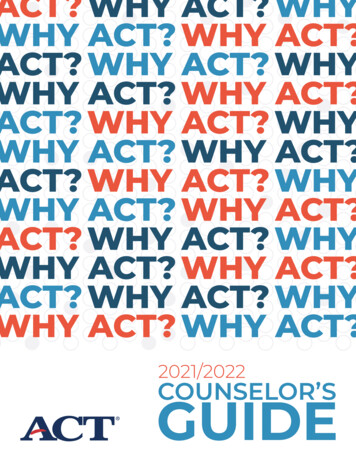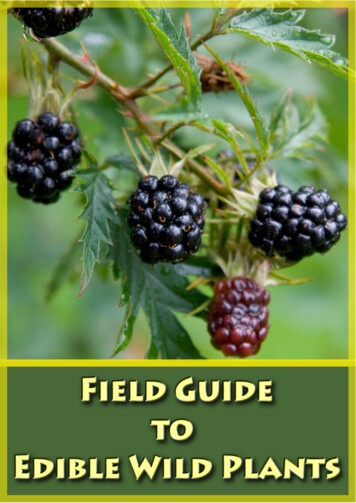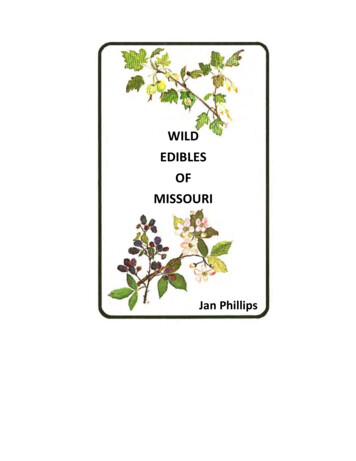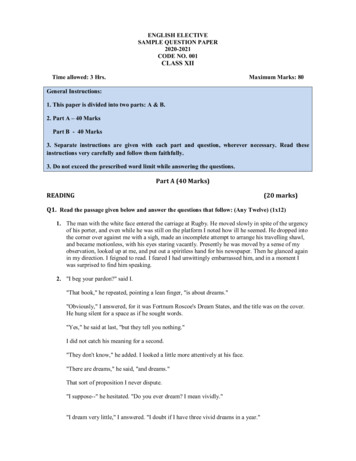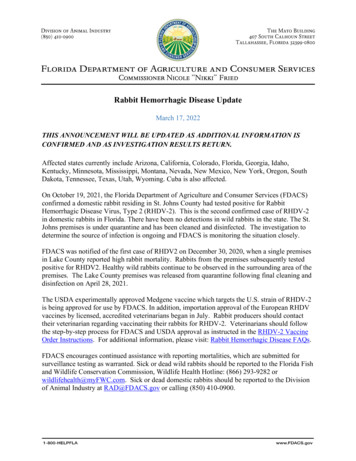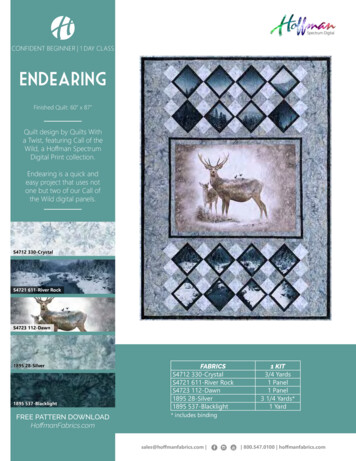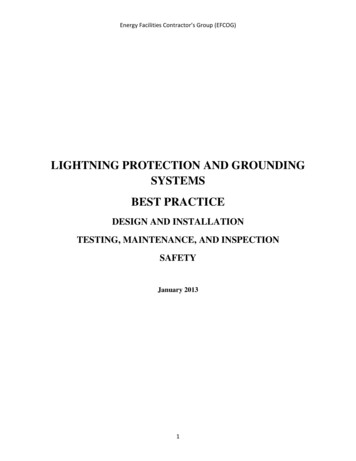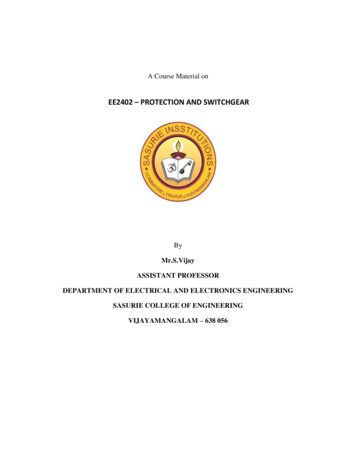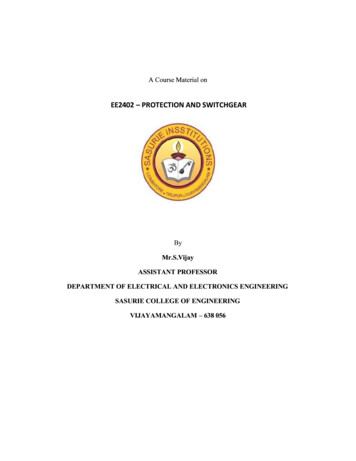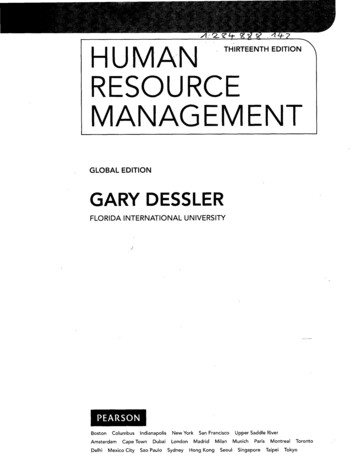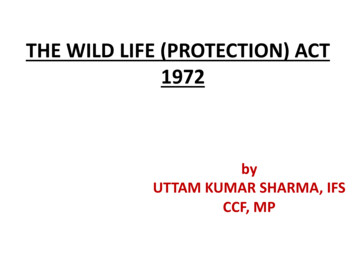
Transcription
THE WILD LIFE (PROTECTION) ACT1972byUTTAM KUMAR SHARMA, IFSCCF, MP
History of wild life protection During British period– Wild Bird Protection Act 1887– Wild Birds and Animals( Protection ) Act 1912– Amendments Act 1935
How did WPA come into being?ü The Parliament under Article 252 of theConstitution received resolutions from theLegislatures of Andhra Pradesh, Bihar, Gujarat,Haryana, Himachal Pradesh, Madhya Pradesh,Manipur, Punjab, Rajasthan, Uttar Pradesh andWest Bengal empowering the Parliament to passthe necessary legislation on the subject
Law and Policy available for wildlife protection1. The Wildlife (Protection) Act, 1972i.The Wildlife (Transactions And Taxidermy) Rules, 1973ii. Wildlife (Stock Declaration) Rules, 1973iii. Wildlife (Protection) Licensing (Additional Matters ForConsideration) Rules, 1983iv. Wildlife (Protection), Rules 1995v. Wildlife (Specified Plants- Conditions For Possession ByLicensee) Rules, 1995vi. Wildlife (Specified Plant Stock Declaration) Central Rules,1995.
vii. The Recognition of Zoo Rules, 1992.viii. National Zoo Policy, 1998ix. National Wildlife Action Plan
WPA 1972 - Scheme and scope of the Act - 7 chaptersChapter IISec 3 to 8Chapter III, III-A Sec 9 to 17Authorities to be appointed/constitutedHuntingChapter IV, IV-ASec 18 to 38 Protected AreasChapter V,V-ASec 39 to49Trade & commerce in wildanimals, articles & trophiesChapter VI, VI-A Sec 50 to 58 Prevention & detection of offenceChapter VIISec. 59 to66Miscellaneous6
Major amendments in WLPA
1986 - Notification on 24/11/1986ü Most of the species were transferred from ScheduleIII, IV and V to Schedule I and Part II of Schedule IIü Chapter V – A insertedü Complete Prohibition in trade of Sch I and Part IIof Sch II except trade in imported Ivory
Ø 700 traders filed WPØ Civil writ petition no. 2750 of 1987G R Simon & others Vs. UOIPetitioner’s contentions:i.As many items were transferred from Sch III, IV toSch I and part II of Sch II, legal stocks of petitionerswould be rendered unsalable in 2 months. Thesewill become unlawful and hence it is deprivation ofproperty without authority of law.
Petitioner’s contentions:ii. There is no nexus between the object of preservation ofanimal life and banning and destroying trade/business inanimal articles made therefrom.iii. The amendment was a colourable exercise of power.Parliament has been misled by Minister. Parliament wasmade to believe that ban on trade was to apply to onlyspecified animals and not to all animals.iv. Petitioners will be left jobless without any compensationeven though they carried their business legitimately.
Petitioner’s contentions:v. Petitioners questioned the proposition that protection ofwildlife was in general interest of public– Certain animals like Black Bears, Jackal and otter weredetrimental to cattle and fish etc.– Snakes are harmful and dangerous to human lifeü Protection of large number of wild animalswho had no utility for humans could not be saidto be in public interest.
Respondent’s contentions:i.Wild life forms part of our cultural heritage.ii. Every animal plays a role in maintaining the ecologicalbalanceiii. Its only when human beings tread their natural habitat thatanimals reactiv. Argument that certain wild animals are harmful to life andserve no useful purpose, is misconceivedv. Depletion in numbers of endangered species has a strongnexus with large scale poaching of WL for trade.
Respondent’s contentions:vi. It is necessary to ensure liquidation of the present stock andto stop further accumulation so as to discourage andprevent illegal poaching of wild animals.vii. The Amending Act was not a colorable exercise of power.The power to make necessary changes in the Schedule ofWild Life (Protection) Act vests in the Governmentunder Section 61 of the Act.
G R Simon & others Vs. UOIü HC Delhi issued interim Order on 23 Jan 1987Order : Permitted petitioners to make declaration of stocks Authorize petitioners to manufacture, sell or offer for sale ortransfer to any authorized person the stocks held by them Government to consider renewal of licenses withoutprejudice to the respective rights and contentions of theparties Provision of Amendment act were stayed till disposal of WP
G R Simon & others Vs. UOIü Division bench vacated the stay order on09/02/1993ü SLP to SC was dismissed on 26/02/1993 with thedirection that No fresh prosecution would be launched againstpetitioners for possession of existing stocks till the WPfinally disposed off.
G R Simon & others Vs. UOIü Final order by 3 member bench on 20/03/1997:– Provision of chapter V-A introduced by AmendingAct 1986 to WPA 1972 are Valid and intra vires– Petitioners have been given more than enough timeto dispose of their stocks. Hence they are notentitled to any further time for disposal of stocks
Major amendments in WLPA contd.1991(October) – Major amendments»Protection of specified plant - Ch III-A; Sch VI»For Zoo»Recognized the needs of tribal and forest dwellers» Non officials can directly take instances ofviolationsto courts - Sec 55 (c)»Transportation of WL or WL products prohibited»Total ban on exports of birds»Prohibition of trade in animal articles including banon imported ivory
Major amendments in WLPA contd.Ø Ivory Traders & Manufacturing Association Vs. UOI;HC Delhi– Traders obtained a stay order– Stay lifted on July 7, 1992– Judgment by double bench on 20/03/1997» Trade in imported ivory and articles madetherefrom – prohibition under AmendmentAct 1991- VALID
HC held that“Prohibition on all International Trade in Ivory imported into India or an article made therefrom, from specifieddate mentioned in Amending Act of 1991, is no violationof fundamental rights. This also includes MammothIvory.”Ivory Traders & Mfg. Association vs Union ofIndia, AIR 1997, Del 267
“A mere perusal of the definition of ‘animal article’ in Section 2(2) of the Act would show that the imported ivory falls within it.In that view of the matter the question as to whether theAfrican Elephant is a scheduled animal or not is irrelevant.Dealing in trade in ivory is prohibited under Chapter V-A.§ Total Prohibition on trade in ivory under the WPA, held to bereasonable.Indian Handicrafts Emporium and OthersvsUnion of India and Others (2003) 7 SCC 589
Balram Kumawat’s case, (2003) 7 SCC 628Issue - Whether ‘mammoth ivory’ imported in India answersthe description of the words ‘ivory imported in India’contained in Wild Life (Protection) Act, 1972’Petitioner’s case§ WPA 1972 does not apply on Mammoth Ivory§ Mammoth belongs to an extinct species, while the ivory ofthe elephant is of an extant living animal.§ Mammoth ivory is distinguishable by visual and nondestructive means vis-a vis elephant ivory.
Supreme Court held:§What has been banned under the Act is ivory.§‘Ivory’ as per dictionary meaning is not confined to elephantivory.§ It does not say that what is prohibited is trade in elephantivory or either types of ivory.§The parliament in the Act has used the term ‘ivory’ insteadof elephant ivory and one cannot assume that theparliament used this term without being aware ofexistenceof different types of ivory.
Supreme Court contd § If the intention of the parliament was to confine thesubject matter of ban under Act toelephant ivory alonethen it would have said so explicitly§ The purport and object of the Act is that nobody can carryon business activity in imported ivory.
Major amendments in WLPA contd 2002 – Preamble changed,-Addition :- Chap VI –A- forfeiture of property derivedfrom illegal hunting & trade- power to remove encroachment; Sec 34-A- conservation reserve & community reserve;Sec 36–A to 36-D2006– NTCA (National Tiger Conservation Authority)- WCCB( wildlife Crime Control Bureau)
J&K Wild life (Protection) Act 1978 Amendment 2002
THE WILDLIFE (PROTECTION) ACT, 1972(No. 53 of 1972)(9th September, 1972)An Act to provide for the protection of Wildanimals, birds and plants and for matters connectedtherewith or ancillary or incidental thereto with aview to ensuring the ecological and environmentalsecurity of the country.
On the Preamble of WPA, Supreme Court says The preservation of the fauna and flora, some species of whichare getting extinct at an alarming rate, has been a greatand urgent necessity for the survival of the humanity andthese laws reflect a last-ditch battle for the restoration, inpart at least, a grave situation emerging from a long historyof callous insensitiveness to the enormity of the risks tomankind that go with the deterioration of environment.State of Bihar Vs. Murad Ali Khan, AIR 1989 SC of 1
CONTENTSCHAPTER IPreliminary Short title, extent, and commencement Definitions
CHAPTER 1Preliminary1. Short title, extent, and commencement, (1) This Act may be called the Wildlife (Protection) Act, 1972.(2) It extends to the whole of India, except the State of Jammu andKashmir.(3) It shall come into force in a State or Union Territory to which itextends, on such date as the Central Government may, by notification,appoint, and different dates may be appointed for different provision ofthis Act or for different States or Union Territories.
2. Definitions - In this Act, unless the context otherwise requires, (1) ‘animal’ includes mammals, birds, reptiles, amphibians, fish, otherchordates and invertebrates and also includes their young and eggs;(2) “animal article” means an article made from any captive animal orwild animal, other than vermin, and includes an article or objectin which the whole or any part of such animal has been used andivory imported into India and an article made there from.(3) Omitted 1991(4) “Board” means a state board for Wildlife constituted under subsection (1) of Sec.6;
Definitions contd.(5) “captive animal” means any animal, specified in Schedule I,Schedule II, Schedule III or Schedule IV, which is capturedor kept or bred in captivity;(6) Omitted 1991(7) “Chief Wildlife Warden” means the person appointed assuch under C1. (a) of sub-section (1) of Sec.4;(7A) “Circus” means an establishment, whether stationary ormobile where animals are kept or used wholly or mainlyfor the purpose of performing tricks or manoeuvers;(8) Omitted in 2003
Definitions contd.(9) “Collector” means the Chief Officer in charge of the revenue administration ofa district or any other officer not below the rank of a Deputy Collector as maybe appointed by the State Government under section 18B in this behalf;(10) “commencement of this Act”, in relation to –(a) a State, means commencement of this Act in that State.(b) any provision of this Act, means commencement of that provision in theconcerned State;(11) “dealer” in relation to any captive animal, animal article, trophy, uncuredtrophy, meat or specified plant, means a person who, carries on the businessof buying or selling any such animal or article, and includes a person whoundertakes business in any single transaction(2003);
Definitions contd.(12) “Director” means the person appointed as Director ofWildlife Preservation under Cl(a). of sub-section (1) of Sec. 3;(12A) “Forest Officer” means the Forest Officer appointedunder clause (2) of Sec.2 of the Indian Forest Act, 1927(16 of 1927) or under any other Act for the time being inforce in a state ;(12B) “forest produce” shall have the same meaning as in subclause (b) of clause (4) of Sec. 2 of the Indian Forest Act,1927 (16 of 1927);
Definitions contd.(13) Omitted 1991(14) “Government property” means property, referred to insec.39; [or sec. 17H](15) “habitat” includes land, water, or vegetation which is thenatural home of any wild animal;
Definitions contd.(16) “hunting”, with its grammatical variations and cognateexpressions, includes,(a) killing or poisoning of any wild animal or captive animal andevery attempt to do so;(b) capturing, coursing, snaring, trapping, driving or baiting anywild or captive animal and every attempt to do so;(c) injuring or destroying or taking any part of the body of anysuch animal, or in the case of wild birds or reptiles, damaging theeggs of such birds or reptiles, or disturbing the eggs or nests ofsuch birds or reptiles;
Definitions contd.(17) “land” includes canals, creeks, and other water channels,reservoirs, rivers, streams and lakes, whether artificial or natural,marshes and wetlands and also includes boulders and rocks;(18) “licence” means a licence granted under this Act;(18A) “livestock” means farm animals and includes buffaloes, bulls,bullocks, camels, cows, donkeys, goats, sheep, horses, mules,yaks, pigs, ducks, geese, poultry and their young but does notinclude any animal specified in Schedule I to V
Definitions contd.(19) “manufacturer” means a person who manufacturesarticles from any animal or plant specified in ScheduleI to V and VI, as the case may be;(20) “meat” includes blood, bones, sinew, eggs, shell orcarapace, fat and flesh with or without skin, whetherraw or cooked, of any wild animal or captive, otherthan vermin;(21)“National Board” means the National Board for WildLife Constituted under Sec.5A
Definitions contd.(22) “notification” means a notification published in the officialGazette;(23) “permit” means a permit granted under this Act or any rulemade thereunder;(24) “Person” includes a firm;(24A) “protected area” means a national Park, a sanctuary, aconservation reserve or a community reserve notified undersections 18, 35, 36A and 36C of the Act;(25)“prescribed” means prescribed by rules made under this Act;(25A) ”recognised zoo” means a zoo recognised under section 38H;
Definitions contd.(25B) “reserve forest” means the forest declared to be reserved by theState Government under sec.20. of the Indian Forest Act, 1927(16 of 1927); or declared as such under any other State Act;(26)“sanctuary” means an area declared as a sanctuary by notificationunder the provisions of chapters IV of this Act shall also include adeemed sanctuary under sub- section (4) of Section 66:(26-A) or sec 38, or deemed, under sub section (3) of Sec.66 to bedeclared, as a wildlife sanctuary;(27)“specified plant“ means any plant specified in Schedule VI;(28)[Omitted 2002.]
Definitions contd.(29) “State Government”, in relation to a Union Territory, meansthe Administrator of that Union Territory appointed bythe President under Art 239 of the Constitutions ;(30) “taxidermy”, with its grammatical variations and servation or mounting of trophies;(30A) “territorial waters” shall have the same meaning as in Sec.3.of Territorial waters, Continental Shelf, Exclusive Economic Zoneand other Maritime Zones Act, 1976 (80 of 1976);
Definitions contd.(31)“trophy” means the whole or any part of any captiveanimal or wild animal, other than vermin, which has beenkept or preserved by any means, whether artificial or natural,and includes,(a) rugs, skins, and specimens of such animals mounted inwhole or in part through a process of taxidermy, and(b) antler, bone, carapace, shell, horn, rhinoceros horn,hair, feather, nail, tooth, tusk, musk, eggs, and nests andhoneycomb;
Definitions contd.(32) “uncured trophy” means the whole or any part ofany captive animal, other than vermin, which has notundergone a process of taxidermy, and includes afreshly killed wild animal ambergris, musk and otheranimal products ;
Shahtoosh shawl – Animal article? Cottage Industries Exposition . vs Union Of India (Uoi) And Ors. on 3September, 2007, HC DelhiPetitioners contention:– 'Shahtoosh' derived from the fallen hair of Chiru oncewoven into a shawl ceased to be preserved or kept in itsnatural from and also does not find a specific mention inthe definition of "animal article". Therefore such a shawldoes not fall within the ambit of the prohibition underthe Act extended to "animal articles."
ü Sec (2)(2)- “animal article” means an article madefrom any captive animal or wild animal, other thanvermin, and includes an article or object in which thewhole or any part of such animal has been used andivory imported into India and an article madethere from.
Court observed:1. It cannot be construed by any means that 'hair' has beenspecifically left out of the definition of 'animal articles'merely because it is mentioned in the definition of"trophy".2. The raw wool of Chiru after treating and processingwould in fact fall within the meaning of the trophy. In ourview, the definitions of 'uncured trophy’, 'trophy' and'Scheduled animal articles' are not separate, distinct andexclusive compartments but are complementary to oneanother. Any other construction would defeat the objectof the Act and the intention of the legislature.
Court observed:3. the raw 'hair’ of Chiru after treatment andprocessing would admittedly fall within themeaning of 'trophy'. The thread made from suchprocessed wool including the shawl woven fromsuch thread would be covered by the definition of'animal article' as defined in Section 49A(b) in asmuch as both the thread and the shawl are articleswhich have been made by use of hair(wool) of ascheduled wild animal.
Wildlife Trivia . The term “wild life” (written as two words) was firstused by the famous American Zoologist WilliamTemple Hornaday in his book “Our Vanishing WildLife (Its Extermination and Preservation)” publishedin 1913. it was only in 1930s that “wildlife,” written asa single word, came into widespread usage.Wildlife means the native wild fauna and flora of aregion. As per section 2(37) of WPA 1972, “wildlife”includes any animal, aquatic or land vegetation whichforms part of any habitat.
Coral – Animal article? State of Tamil Nadu and Another v. Messrs KaypeeIndustrial Chemicals Private Limited and Others- Madras High Court (single bench) 2004.ü Fact of the case: MoEF issued notification dated 11.7.2001 All corals included in Schedule I, Part IV A - Coelenterates1. Reef Building Coral (All Scleractinians)2. Black Coral (All Antipatharlans)3. Organ Pipe Coral (Tubipora musica)4. Fire Coral (All Hillipora species)5. Sea Fan (All corgenians)
Coral – Animal article?Petitioners contention:– Petitioners are using a hard, white calcareous substance called‘coral'.– This coral is a lifeless substance which is secreted by marinepolyps (also called coral). When the marine polyps die due tovarious reasons, the secreted calcareous lifeless substancebreaks from the coral and falls on the sea floor, and the same iscarried away by sea currents and washed ashore.– The same is collected by the fisherfolk, and are sold to thepetitioners for the manufacture of lime.
Coral – Animal article?Defense arguments:– Contention of the petitioners that the corals breakaway from the reefs and are carried away from thesea currents and finally collected by the fishermen ismisconceived.– Corals are invariably collected from the sea beds bybreaking the natural attachment to the sub-stratumcausing extensive ecological damage to the whole ecosystem
Coral – Animal article?Defense arguments:– The corals are mostly damaged by the trawlers thatmove inside the creeks for illegal fishing and in turndamage the corals which are collected by the peoplefor use as raw material by the lime industry.– These industries cannot sustain on incidentally brokencorals brought ashore with sea currents. Such aquantum can only be produced through exploitation.
Coral – Animal article?Defense arguments:– Corals are wild animals and form an integralcomponent of the marine ecosystem, and thereforethe notification issued on 11.7.2001 comes within theambit of the Act.– Corals, whether dead or alive, are the property of theGovernment. Collection, possession and trade in suchspecies is illegal.
Madras High Court (single bench) decision 2004:– notification dated 11.7.2001 by itself does not authorizethe respondents to interfere with the business of thepetitioners, who are only purchasing the "coral reef" orouter skeleton of dead sea animal, which is washedashore after the death of the reef building coral.– the external skeleton of dead marine animals formingsuch reef by itself cannot be considered as "ReefBuilding Coral".– Hence it cannot be considered as "wild life" or "wildanimal" as defined in the Act.
Definitions contd.(36) “wild animal” means any animal specified inSchedules I to IV and found wild in nature(37) “wildlife” includes any animal, aquatic or landvegetation which forms part of any habitat
State of Tamil Nadu and Another v. Messrs KaypeeIndustrial Chemicals Private Limited and Others-2005 AIR (Mad) 304, Madras High Court (double bench)ü Decision:– allowed the collection of coral for commercial use inlime manufacture.– It held that dead pieces or the outer skeleton of aprotected marine living organism would not fall withinthe definition of animal article or wild animal andtherefore its collection was not banned.
The judgment was appealed by the State tothe Supreme Court SC granted a stay on operation of judgment ofdivision bench in 2005. Owing to the stay, the Madras High Courtdeclined to allow collection of coral in C.Rathinavel v. State of Tamil Nadu and Others2008
Definitions contd.(33) “vehicle” means any conveyance used for movement onland, water or air, and includes buffalo, bull, bullock, camel,donkey, elephant, house, and mule;(34) “vermin” means any wild animal specified in Sch.V;(35) “weapon” includes ammunition, bows and arrows,explosives, firearms, hooks, knives, nets, poison, snares,traps, and any instrument or apparatus capable ofanaesthetizing, decoying, destroying, injuring or killingan animal;
Definitions contd.(36) “wild animal” means any animal specified inSchedules I to IV and found wild in nature(37) “wildlife” includes any animal, aquatic or landvegetation which forms part of any habitat(38) “Wildlife Warden” means the person appointed assuch under C1. (b) of sub-section (1) of Sec.4;
Definitions contd.(39) “zoo” means an establishment, whether stationaryor mobile, where captive animals are kept forexhibition to the public and includes a circus andrescue center but does not include an establishmentof a licensed dealer in captive animals.
The Act has been made applicable in various States andUnion Territories as under:1. Andaman and Nicobar, w.e.f. Ist July 1973, vide G.S.R.332(E), dated Ist July, 1973.2. Andhra Pradesh, w.e.f. Ist July 1973, vide G.S.R.371 (E),dated Ist August, 1973.3. Arunachal Pradesh, w.e.f. 15th May 1973.4. Assam, w.e.f. 25th January 1977, vide G.S.R.33 (E), dated25th January, 1977.5. Bihar, w.e.f. Ist February 1973, vide G.S.R.40 (E), dated IstFebruary, 1973.
6. Dadra and Nagar Haveli, w.e.f. Ist September 1973, vide G.S.R.441(E),dated Ist September, 1973.7. Delhi, w.e.f. Ist June 1973,8. Gao Daman and Diu, w.e.f. 16 July 1973, vide G.S.R.629 (E), dated 16thJuly, 1973.9. Gujarat, w.e.f. Ist February 1973, vide G.S.R.62 (E), dated Ist February,1973.10. Haryana, w.e.f. 12th March July 1973, vide G.S.R.63 (E), dated 12March, 1973.11. Himachal Pradesh, w.e.f. 2nd April ly 1973, vide G.S.R.190 (E), dated2nd April, 1973.12. Kerala, w.e.f. Ist June 1973, vide G.S.R.293 (E), dated Ist June, 1973.
13. Lakshdweep, w.e.f. Ist November 1973, vide G.S.R.481(E), dated IstNovember, 1973.14. Madhya Pradesh, w.e.f. 25 January 1973, vide G.S.R.28 (E), dated 25January, 1973.15. Maharashtra, w.e.f. Ist June 1973, vide G.S.R.296 (E), dated Ist June, 1973.16. Manipur, w.e.f. 15th May 1973, vide G.S.R.269 (E), dated 15th May, 1973.17. Meghalaya, w.e.f. Ist April 197718. Mizoram, w.e.f. Ist October 1974, vide G.S.R.407 (E), dated Ist October,1974.19. Mysore, w.e.f. Ist July 1973, vide G.S.R.355 (E), dated Ist July, 1973.
20. Nagaland, w.e.f. 18th December 1981, vide G.S.R.668 (E), dated18thDecember21. Orissa, w.e.f. 14th August 1974, vide G.S.R.364 (E), dated 14thAugust, 1974.22. Punjab, w.e.f. Ist April 1975.23. Rajasthan, w.e.f. Ist September 1973, vide G.S.R.410 (E), dated IstSeptember, 1973.24. Sikkim, w.e.f. Ist May 1976, vide G.S.R.311 (E), dated Ist May, 1976.25. Tamil Nadu, w.e.f. Ist January, 1974.26. Tripura, w.e.f. 2nd October 1973, vide GS.R.465 (E), dated 2ndOctober, 1973.
27. Union Territory of Chandigarh, w.e.f. 2nd December 1974,vide G.S.R.674 (E), dated 2nd December, 1974.28. Union Territory of Pondicherry, w.e.f. Ist March 1975, videG.S.R.62 (E), dated Ist March,197529. Uttar Pradesh, w.e.f. Ist February 1973.30. West Bengal, w.e.f. Ist May 1973, vide G.S.R.224 (E), datedIst May, 1973.
CHAPTER IIAuthorities to be appointed or constituted under the Act3. Appointment of Director and other officers4. Appointment of Chief Wildlife Warden and other officers5. Power to delegate6. Constitution of the Wildlife Advisor-Y, Board7. Procedure to be followed by the Board8. Duties of the Wildlife Advisory Board
CHAPTER IIAuthorities to be appointed or constituted under this Act3. Appointment of Director another officers.–(1) The Central Government may, for the purposes of thisAct appoint(a) a Director of Wildlife Preservation;(b) Omitted 2003;(c) such other officers and employees as may benecessary
Authorities to be appointed or constituted under this Act contd.(2) In the performance of his duties and exercise of hispowers by or under this Act, the Director shall besubject to such general or special directions, as theCentral Government may, from time to time, give.(3) The officers and other employees appointed underthis section shall be required to assist the Director.
Authorities to be appointed or constituted under this Act contd.4. Appointment of Chief Wildlife Warden and otherofficers –(1) The State Government may, for the purposes of thisAct, appoint –(a) a Chief Wildlife Warden;(b) Wild life Wardens;(bb) Honorary Wildlife Warden(c) such other officers and employees as may benecessary.
Authorities to be appointed or constituted under this Act contd.(2) In the performance of his duties and exercise of hispowers by or under this Act, the Chief Wildlife Wardenshall be subject to such general or special directions, asthe State Government may, from time to time, give.(3) The Wildlife Warden, the Honorary Wildlife Warden andother officers and employees appointed under thissection shall be subordinate to the Chief Wildlife Warden.
Authorities to be appointed or constituted under this Act contd.5. Power of delegate(1) The Director may, with the previous approval of the CentralGovernment, by order in writing delegate all or any of his powersand duties under this Act to any officer subordinate to him subjectto such conditions, if any, as may be specified in the order.(2) The Chief Wildlife Warden may, with the previous approval of theState Government by order in writing, delegate all or any of hispowers and duties under this Act, except those under Cl.(a) of subsection (1) of Sec.11, to any officer subordinate to him subject tosuch conditions, if any, be specified in the order.
Authorities to be appointed or constituted under this Act contd.(3) Subject to any general or special, direction given orcondition imposed by the Director or the Chief WildlifeWarden, any person, authorised by the Director or theChief Wildlife Warden to exercise any, powers, mayexercise those powers in the same manner and to thesame effect as if they had been conferred on that persondirectly by this Act and not by way of delegation.
Authorities to be appointed or constituted under this Act contd.5A. Constitution of the National Board for Wild Life. –(1) The Central Government shall, within three monthsfrom the date of commencement of the Wild Life (Protection)Amendment Act, 2002, constitute the National Board for Wild Lifeconsisting of the following members, namely: (a) the Prime Minister as Chairperson;(b) the Minister in-charge of Forests and Wild Life as ViceChairperson;(c) three members of Parliament of whom two shall be fromthe House of the People and one from the Council of States;
Authorities to be appointed or constituted under this Act contd.(d)(e)(f)(g)(h)(i)(j)(k)(l)Member, Planning Commission in-charge of Forests and Wild Life;five persons to represent non-governmental organizations to benominated by Central Government;ten persons to be nominated by the Central Government fromamongst eminent conservationists, ecologists and environmentalist;the Secretary to the Government of India in-charge of the Ministryor Department of the Central government dealing with Forests andWild Life;the Chief of the Army Staff;the Secretary to the Government of India in-charge of the Ministryof Defence;the Secretary to the Government of India in-charge of the Ministryof Information and Broadcasting;the Secretary to the Government of India in-charge of theDepartment of Expenditure, Ministry of Finance;the Secretary to the Government of India, Ministry of Tribal Welfare
Authorities to be appointed or constituted under this Act contd.(m)(n)(o)(p)(q)(r)(s)(t)(u)(v)(w)the Director-General of Forests in the Ministry or Department ofthe Central Government dealing with Forests and Wild Life;the Director-General of Tourism, Government of India;the Director-General, Indian Council for Forestry Research andEducation, Dehradun;the Director, Wild Life Institute of India, Dehradun;the Director, Zoological Survey of India;the Director, Botanical Survey of India;the Director, Indian Veterinary Research Institute;the Member-Secretary, Central Zoo Authority;the Director, National Institute of Oceanography;one representative each from ten States and Union Territories byrotation, to be nominated by the Central Government;the Director of Wild life Preservation who shall be the MemberSecretary of the National Board.
Authorities to be appointed or constituted under this Act contd.(2) The term of office of the members other than those who are membersex off
History of wild life protection During British period –Wild Bird Protection Act 1887 –Wild Bird

